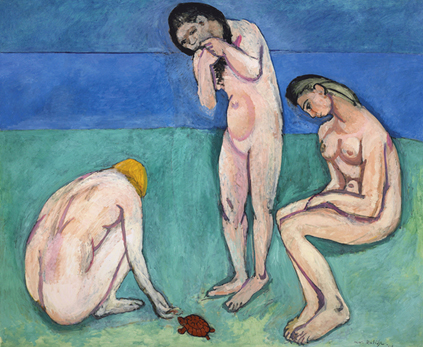Andrew Graham-Dixon finds artists with their backs to the future in 'On Classic Ground' at the Tate Gallery
Hung on a wall the colour of ripe corn, Henri Matisse's radiant Bathers with a Turtle makes it hard to concentrate on anything else in the vicinity. Take away the figures and it's a Rothko prototype: shore, sea and sky rendered in bands of saturated colour, blues and turquoises that alternate between uninflected smoothness and the patchiness of pictorial readjustment, areas of overpainting reflecting late changes of mind. Matisse's subject is mysterious, comedy never far away: three ladies startled by a turtle.
Matisse's figures are raw chunks of humanity with a trace of Gothic about them. The standing nude, seemingly based on Eve in Masaccio's Expulsion of Adam and Eve, has her hands crammed into her mouth in a reflex that suggests some dreadful unnamed anxiety. Maybe she has been stunned by the realisation that this turtle feeding on a lettuce leaf represents all, in the end, that life comes down to: hunger and its appeasement. Matisse painted out the yachts floating on the sea and the bathers' towels he had once thought to include lying nearby, so what you are left with is disconcertingly simple: primal figures in a primal landscape, witnesses to the satisfaction of a primal biological urge.
This is the Tate's way of placing you ''On Classic Ground''. It is an extremely ambitious show, an attempt to define what its subtitle designates ''The New Classicism 1910-1930''. The territory surveyed by the Tate's show, which restricts itself to French, Spanish and Italian art, is exclusively Mediterranean, so Matisse's painting, with its vivid sea-greens and blues, works usefully as an aid to acclimatisation. But as an introduction to an exhibition supposedly devoted to ''classicism'' it leaves much to be desired....


